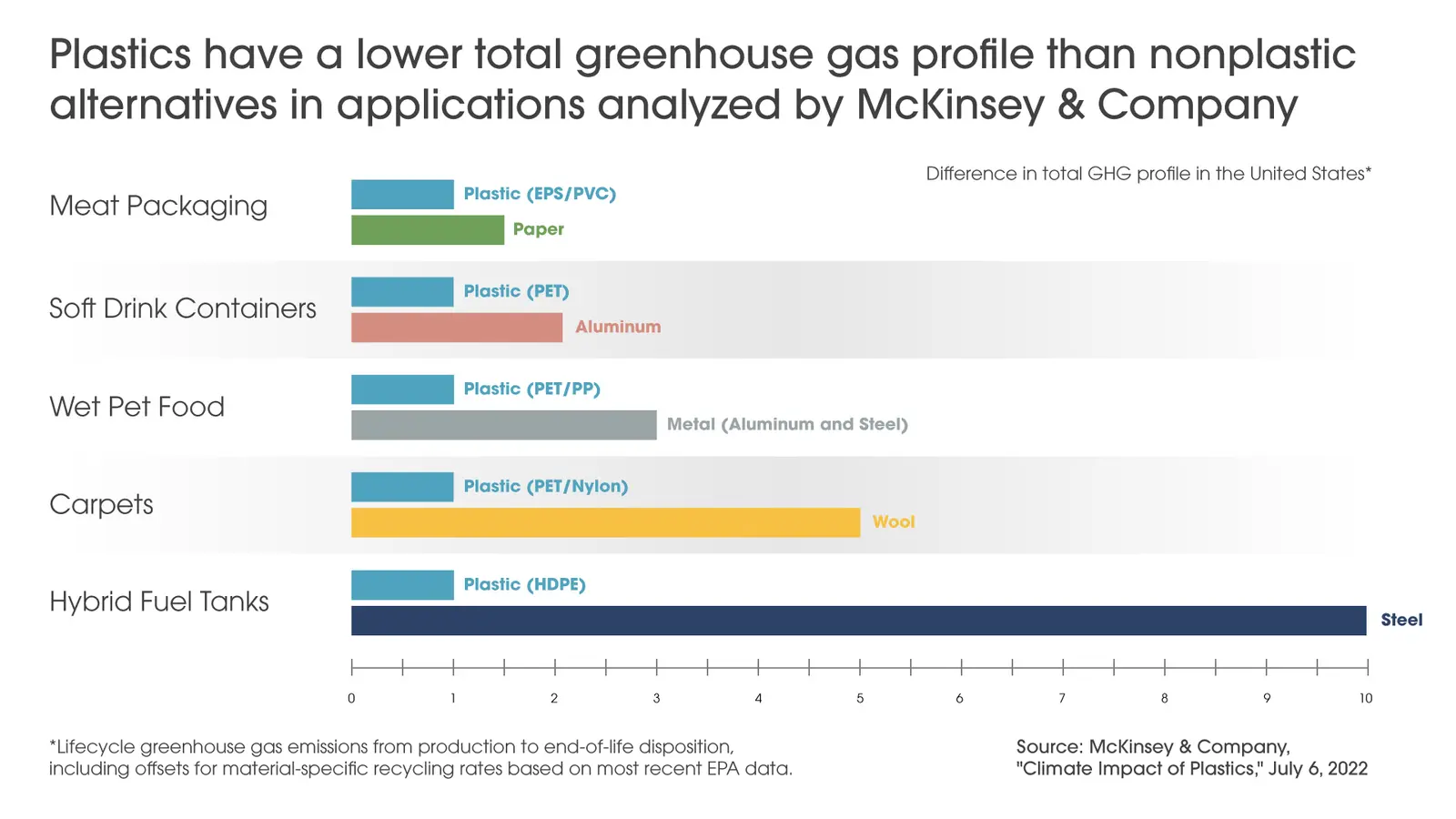What happens when a leading consulting firm takes a good hard and independent look at greenhouse gas emissions (GHGs) from the use of plastics? And compares them to alternative materials such as steel, paper, aluminum and glass?
In July 2022, McKinsey & Company issued a report called Climate Impact of Plastics. Their key finding: “Plastics have a lower total greenhouse gas contribution than alternatives in most applications.”
Turns out that plastics produce less GHGs than available alternatives in 13 out of 14 products measured. In one product, ten times less GHGs!
In reality, we shouldn’t be all that surprised at McKinsey’s findings. Other studies have found similar results.
Based on decades of life cycle analyses (LCAs) that study the environmental impacts of consumer goods, multiple researchers have concluded:
- The use of plastic packaging and products can significantly reduce GHGs compared to alternatives such as steel, paper, aluminum, glass, etc.
- Replacing plastics with alternatives in many applications would significantly increase GHGs.
While studies vary somewhat, research typically shows that using plastic packaging and products results in approximately 2.5 times less GHGs than alternatives (you can read more about these findings).

McKinsey found essentially the same thing. Here’s a synopsis of quotes from their report:
- “This paper examines the total GHG contribution of plastics versus its alternatives, including product life cycle (cradle to grave) and impact of use…”
- “As part of our methodology, we looked closely at examples from five sectors with the highest consumption of plastics—packaging, building and construction, automotive, textiles, and consumer durables—representing around 90 percent of global plastics volume.”
- “Two independent LCA experts reviewed our approach, analyses, and findings to ensure that our methodology was scientifically sound and that our assumptions and data sources were robust and reliable.”
- “…the plastics examined in this paper offer a lower total GHG contribution compared with alternatives in 13 of 14 cases.” [Exception: industrial drums.]
- “In the 13 applications for which plastic has lower emissions, the benefit was 10 to 90 percent lower GHG emissions than the next-best alternatives.”
- And as mentioned above, “… the findings are broadly in line with published reports…”
These results run counter to much of what we hear about plastics. Conventional wisdom often leads us to think that the growing use of plastics must be an outsized contributor to climate change. We hear and see it in the news nearly every day.
But McKinsey and others have found largely the opposite: The growing use of plastics actually drives down GHGs compared to alternatives. McKinsey goes even further, noting that increased use of plastics can play a positive role in combatting climate change:
“…plastics adoption in the near term can help decarbonization efforts in these areas, particularly in terms of food spoilage and energy efficiency, given their lower GHG footprint.”
McKinsey
In other words, the increased use of plastics can help reduce carbon emissions (“decarbonization efforts”) by displacing materials with higher GHGs.
Wow. Who knew? 🤔
Well, as noted above, lots of researchers over the past few decades knew this. Multiple studies reached the same conclusions.
So, now we have decades of data. And a leading consulting firm has independently corroborated these facts and figures. And the findings show that the use of plastics advances our efforts to combat climate change.
Isn’t it time to scrap conventional wisdom and instead rely on science when creating public policy on climate change?
Examples from the McKinsey Report:
- Use of plastic (polyethylene) fuel tanks for hybrid cars results in 90% lower GHGs (10X) than steel tanks.
- Use of plastic (polyurethane) foam insulation results in 80% lower GHGs than fiberglass insulation.
- Use of plastic (PVC) sewer pipes results in 35-45% lower GHGs than concrete or ductile iron pipes.
Learn more about plastics and climate change. Read the McKinsey Report.

